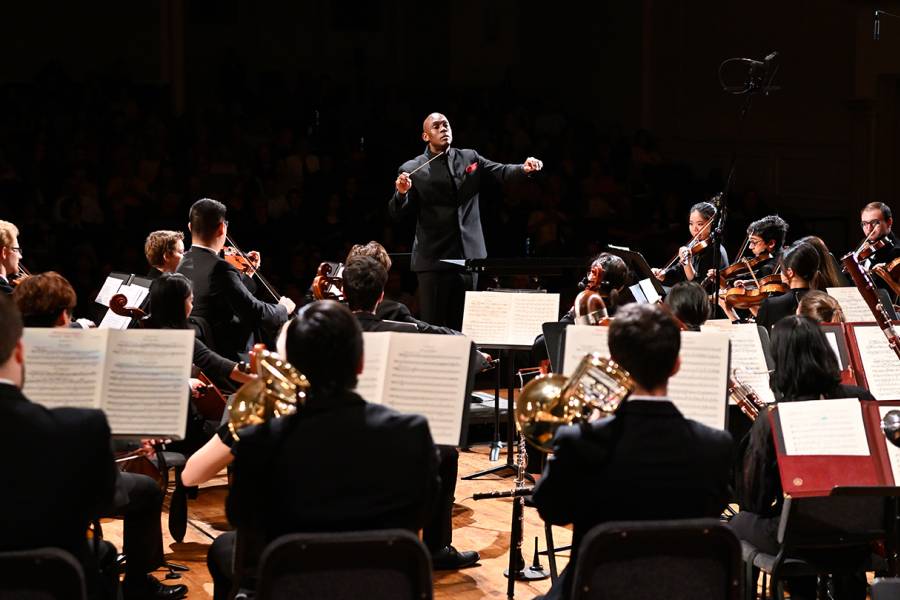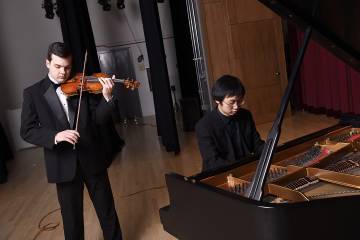While the coronavirus pandemic has forced many cultural institutions to reorganize and reexamine their missions, those dedicated to the performing arts face unique challenges. With social distancing measures in place, live concerts, theater, and dance performances have been canceled or postponed, while in-person instruction—even for conservatories—has moved entirely online.
To learn more about how performing arts institutions have responded to these unprecedented changes caused by COVID-19, the Hub reached out to Fred Bronstein, dean of the Johns Hopkins Peabody Institute. A preeminent arts administrator, Bronstein formerly served as president of the St. Louis Symphony, the Dallas Symphony Orchestra, and the Omaha Symphony.
What short- and long-term changes do you anticipate for performing arts institutions as a result of the coronavirus pandemic?
I think that for performing arts institutions, it's clearly an enormously challenging time. Beyond the total loss of public performance translating to lost ticket revenue, there's also the loss accompanying fundraising efforts and, along with it, smaller endowments due to investment losses in the growing recession. For performing arts organizations, the big challenge is that they work on very thin margins and have limited reserves. Something I think will have a profound impact due to COVID-19, though hopefully not a lasting one, will be the recovery from this financial shock.
I will say this: Arts organizations and orchestras have been around for hundreds of years. They have found a way through before and will find a way this time, too, but it's undoubtedly an enormous challenge. Still, I think every arts organization is interested in the potential that technology offers. Like everyone else, arts institutions have had to move instantaneously online. For what we do, it's been a particular challenge.
Hopefully, this will build on what many arts organizations have been already doing in finding new ways to reach audiences. The pandemic has exponentially driven that conversation ahead, and that's been a silver lining going forward. We're finding new ways for performers to be innovative and get their product out there. It is something that the performing arts world was thinking about before but we're thinking about it much more intently today.
One thing we teach our students at Peabody is that, as artists, you have to become as flexible as possible. This was true even before the pandemic. But the pandemic is a genuine life lesson on adapting and being flexible in what it means to create a performance for an audience. There are always going to be new and different ways to reach audiences, and we're seeing this take shape in real time.
What can performers and their institutions do to continue performances during this period of social distancing?
For educational institutions, classes and one-on-one lessons must be taught online. One interesting thing is that while you can't focus on some aspects as readily, like sound quality, at the same time you can focus on other things. For example, an instructor might watch a piano student's hand positioning more intently than they were before. This is to say that there's plenty of room to refocus on certain things that can still be useful.
Ensembles, however, are trickier. Some performers are creating mini chamber music performances. It gets harder as the ensemble gets bigger, but with smaller groups you can create a smaller chamber music experience.
These are many ways that artists can be creative and continue to express themselves and express their craft. For example, at Peabody we have launched a program called ArtReach, which is our platform for archived concerts and "living room concerts" performed from the homes of our students and faculty, as well as brief musical moments and teaching vignettes.
Image caption: The April 10 watch party, held as part of ArtReach, featured the work of Gustav Mahler
Peabody alumni are also involved. One of my favorite examples is Elizabeth Sarian, who is with the Atlanta Opera Studio and is making "singing telegrams" for health care workers and patients.
We're also seeing orchestras, opera companies, and other performing arts organizations around the world push out virtual performances and master classes coming from performers' homes through all kinds of modalities. And just recently there was an impromptu concert by a violinist on a rooftop in Italy that was widely circulated on social media. It brought out hundreds of people on their balconies to listen.
How has the coronavirus pandemic changed initiatives intended to expand and diversify the ranks of classical artists and audiences?
To me, it doesn't and shouldn't change it. That's because building diversity in the performing arts, especially in classical music and dance, is an existential issue for the future of the field. If you look at the changes in demographics coming over the next 30 and 40 years in the United States, and combine it with the challenges of building new audiences, in order to build audiences in the future we will have to be far more diverse than we've been in the past. That means creating a more diverse group of performers who represent the audiences they're going to want to attract in the future. That issue is unchanged.
Being a 21st-century musician means being engaged in building audiences, creating community engagement, and using technology. The pandemic has been a real-world experience in using all these skills.
What role can the performing arts play in helping people through this difficult time?
I think that music and art, but especially music, can come to take on a special meaning when we are really challenged, either individually or as a community. The image that always comes to mind for me is from after 9/11 of Yo-Yo Ma at Ground Zero playing a solo Bach cello suite. It's a moment I've come back to often because it speaks profoundly to how much meaning music takes on when we face a difficult moment. It's a source of inspiration, and comfort, and it can be a necessary diversion. Music is there even when we can't leave our houses. And it's more important than ever.
Posted in Arts+Culture, Voices+Opinion
Tagged fred bronstein, q+a, coronavirus, covid-19










